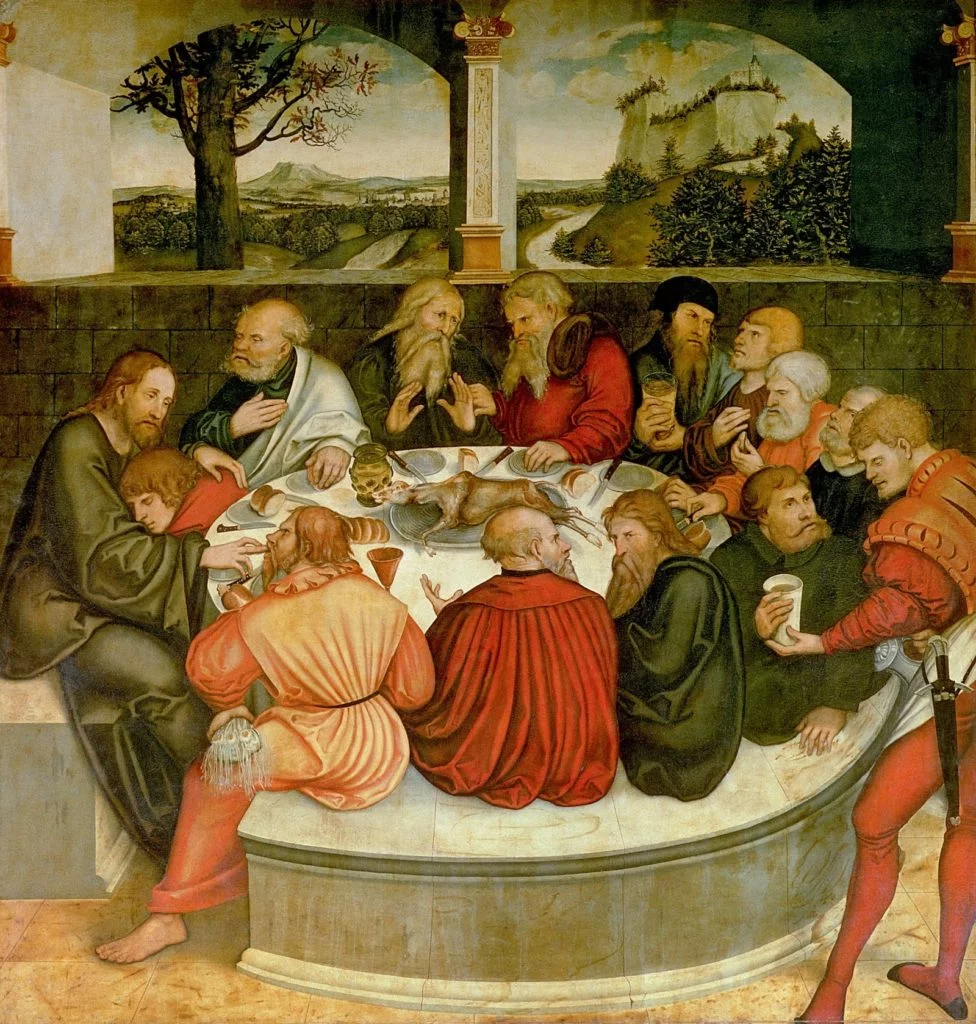Mark’s story of Jesus’ last supper with his disciples is very brief. There is no reference here to the Passover itself, but that it is a Passover meal is surely significant. This memorial feast of Israel’s deliverance, of God’s action and revelation, of a new beginning within the story of the covenant people, of the rich symbolism of the Lamb’s blood and its sacrificial import: all this and more is in the background. You can read Mark’s account of the Last Supper here.
In Mark’s telling, there is no instruction to ‘do this in remembrance of me.’ There is, however, Jesus’ own statement that he will not again drink of the fruit of the vine “until that day when I drink it new in the kingdom of God.” Jesus looks forward, beyond his death, to a new day in the coming kingdom. He—the one who will be betrayed and handed over, who will be executed—he will drink again. This foreshadows the resurrection. Albert Schweitzer speculated that Jesus thought that God would intervene to rescue him prior to his death. Within Mark’s story, however, Jesus clearly anticipates his death: “the Son of Man came . . . to give his life as a ransom for many” (10:45). In this text, too, his blood will be poured out for many. And yet, he will again drink it ‘new in the kingdom of God.’
Mark’s account includes both sign and saying. Jesus took the bread and having blessed (presumably, and in accordance with normal Jewish practice, he was blessing God rather than the bread), broke it and gave it to them, saying, “Take: this is my body.” The four verbs echo Jesus’ compassionate action in the feeding of the five thousand (Mark 6:41) and the four thousand (Mark 8:6). These miracles in the wilderness were kingdom signs, signs of his person and the universal nature of his mission (Senior, The Passion of Jesus in the Gospel of Mark, 56-58). Now he indicates that he himself is the bread, the gift of the kingdom. In giving them the bread he is giving them his own ‘body,’ his own self. Mark’s focus is not on the breaking of the bread but on its distribution: each is to take it. Mark does not say that they ate the bread but it is surely assumed. In their taking, they receive Jesus’ gift of himself, and in their eating they participate in Jesus’ life and fellowship, kingdom and mission.
Jesus takes the cup and gives thanks and gives it to them and “they all drank from it.” Now he interprets this action: “The is my blood of the covenant, which is poured out for many.” This is my body. This is my blood. The signs and the sayings belong together. No doubt Jesus was speaking metaphorically of the bread and the wine, declared to ‘be’ his body and blood. That his blood will be poured out for many refers to his imminent death, and so the parallel saying about the bread now also be similarly understood.
The saying concerning the cup has an additional element: it is Jesus’ ‘blood of the covenant.’ The idea of blood as part of a covenant ceremony had ancient roots (cf. Genesis 15). In Exodus 12 the Israelites celebrated the first Passover by taking the blood of the Passover lamb and smearing it on the door posts and lintels of their homes. The blood thus smeared would be a sign for them: by it, divine judgement would ‘pass over’ their home and they would be spared (Exodus 12:12-13; cf. 21-23). The Levitical regulations and especially the Day of Atonement ritual (Leviticus 16), repeat and deepen the imagery, and the connection between sacrificial blood, God’s covenant promise, and the forgiveness of sins.
Further, this blood of the covenant is ‘poured out for many’: it is for others. Jesus’ death is sacrificial and substitutionary. The emphasis is on Jesus’ action in its intended outcome and purpose; that is, the provision and promise of the covenant rather than human response to the covenant as in Exodus 24:1-8 where the emphasis is on responsive obedience and covenant faithfulness.
This is beautifully portrayed in Lucas Cranach’s central altarpiece at St Mary’s (“City Church”) in Wittenberg. Although not nearly as famous as Leonardo da Vinci’s portrayal of the Last Supper, Cranach’s painting, as a piece of Reformation polemic, portrays Martin Luther as one of the twelve apostles seated around Jesus (being served the cup by a young knight – Lucas Cranach Jnr!). Who is missing to make way for Luther? I don’t know. But the painting suggests a deeper point: we, too, who are followers of Christ are included at the table of the Last Supper, and included in its meaning and promise. More: even those who have not shown themselves the most devoted of followers might find some reason for hope. Cranach portrays Jesus feeding even Judas with the bread of his promise!
